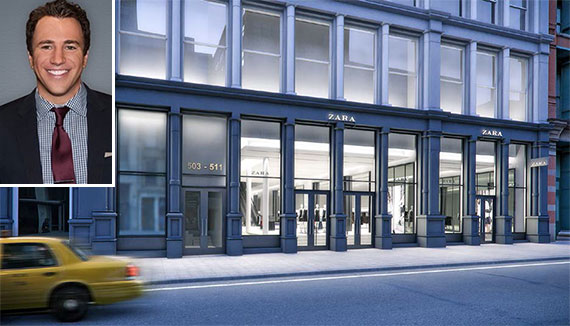Attention-grabbing deals for large retail spaces are distracting from awareness of the fact that pockets of vacancies in some areas of the city may indicate that rents have topped out, and could be heading for a correction.
Among the recent leases making waves were a 20,000-square-foot deal Sephora inked on Lower Fifth Avenue and Foot Locker’s 36,000-square-foot lease south of the Times Square bow tie. And the talk of the town in the Meatpacking District — aside from the opening of the Whitney Museum — continues to be the $250 million, 70,000 square-foot lease tenant-of-the-moment Restoration Hardware signed in October.
“Big deals are happening,” Lee & Associates’ Peter Braus said late last month during a retail forum at TF Cornerstone’s 90 Gansevoort Street, where asking rents for the three retail spaces are $200 per square foot. “Madison is hot again; the Financial District is super-hot; Brooklyn’s having a moment, I think. And it seems like every major … shopping corridor is seeing activity.”
Yet, Braus continued, vacancies in certain submarkets are up, and rents are at unthinkable highs almost across the board. Many are starting to discuss the possibility that prices are too high.
“There is concern that there may be a bit of a bubble,” Michael Hirschfeld, co-head of JLL’s National Retail Tenant Services Group, told The Real Deal. “Rents have escalated to the point where there are concerns about whether or not they’re sustainable. There’s supposed to be a correlation between rents and the opportunity for retail sales.”
Rising rents are a reflection of money flooding into the retail sector, creating competition that is driving purchase prices to new highs. Earlier this year, for example, fashion conglomerate Inditex, the parent company of Zara, paid $284 million for a retail condo on Broadway in Soho, and Savanna bought a Meatpacking retail property at 10th Avenue and 14th Street for $86 million.

David Ash and a rendering of the Zara store at 503 Broadway
The higher prices are, in turn, pushing capitalization rates lower. As a result, investors are seeking higher rents to justify the inflated purchase prices. Cap rates, which measure an investor’s return on investment, averaged 3.64 percent on retail purchases in the first quarter of the year, according to Cushman & Wakefield.
Asking rents have climbed in all but one of Manhattan’s main shopping corridors: Bleecker Street in the West Village. Still, rents on the most prized strips — Upper Fifth Avenue, Times Square and Madison Avenue — grew by only modest amounts, under 5 percent, since early 2014, according to the most recent report by the Real Estate Board of New York.
 Retail experts say they’re starting to see pushback from tenants balking at high asking prices, and nowhere is the conversation more focused than in Soho, where ground-floor asking prices are pushing $1,000 per square foot and above.
Retail experts say they’re starting to see pushback from tenants balking at high asking prices, and nowhere is the conversation more focused than in Soho, where ground-floor asking prices are pushing $1,000 per square foot and above.
However, on the six-block stretch of Broadway more than 20 percent of the storefronts are available for either lease or sublease, according to a review of Agorify data by TRD. And retail specialists who work Soho say tenants are choosing to move to less expensive strips that were once considered less desirable, like Broome Street, where chronic congestion and less foot traffic would have previously outweighed
lower prices.
“Tenants were always concerned about the Holland Tunnel traffic,” said Beth Rosen of RKF, adding that the street has finally reached the critical mass needed to be a viable option for tenants priced out of prime spots.
“I think that the trend I’m seeing is tenants want to be in Soho,” she added. “People are getting creative and finding other streets.”
Times Square’s bow tie is another area where high rents have pushed tenants out beyond the neighborhood’s normal boundaries.
“In Times Square, the bow tie has been stretched,” said JLL’s Craig Slosberg. “I’ve seen spaces as far south as 39th Street and 40th Street calling themselves ‘Times Square South’ and adding large sign packages.”
The question for prime areas may come down to which tenants can afford the highest rents.
Richard Hodos, vice chairman at CBRE, said those with higher margins that can afford to pay 16-to-22 percent occupancy costs — the total of rents, taxes and other costs — can probably continue to justify paying top dollar, while those in the 8-to-12 percent range will probably get squeezed out.
He said he sees a correction coming, not in the form of tenants shutting their doors, but of asking rents gradually coming back down to earth.
“I see more of a softer landing than a bubble bursting. It might be painful for some owners,” he said. “Sometimes it’s like ripping off a Band-Aid all at once, rather than a slow rip. I think it might be more of a slow rip.”
Still, that leaves the question: With investors paying ever-greater sums for properties in the hottest areas, which landlords are set up to absorb a correction, and which will be left feeling the pain?
Jared Epstein of Aurora Capital Associates, which owns a number of retail properties in Soho and the Meatpacking District, said a climate of high rents pushed by compressed cap rates is normally a recipe for disaster. He predicted the coming fallout will separate the inexperienced investors and developers from those on the top of their game.
“They know that retailers will continue to thrive in Soho, the Meatpacking District and along Fifth Avenue, even with surging rents. In these neighborhoods, on a few very select streets, retail sales volumes and branding value continue to justify the rents,” he said. “Top retail investors and developers have a big edge and will continue to flourish, even when the tide turns.”
